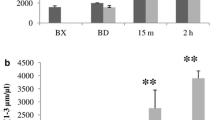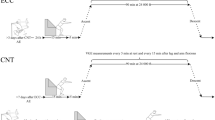Abstract
Purpose
Decompression sickness (DCS) caused by vascular bubble formation is a major risk when diving. Prior studies have shown that physical exercise has a significant impact in both reducing and increasing bubble formation. There is limited knowledge about the mechanisms, but there are indications that exercise-induced muscle injury prior to diving may cause increased bubble formation. The purpose of this study was to investigate the role of exercise-induced muscle injury as a possible mechanism of bubble formation during diving.
Methods
Muscle injury was induced by exposing female Sprague–Dawley rats (n = 30) to a single bout of eccentric exercise, 100 min intermittent, downhill (–16°) treadmill running. Forty-eight hours later, the animals were exposed to a 50-min simulated saturation dive (709 kPa) in a pressure chamber, when the degree of muscle injury and inflammation would be the most pronounced. Bubble formation after the dive was observed by ultrasonic imaging for 4 h.
Results
No difference in bubble loads was found between the groups at any time despite evident muscle injury. Maximum bubble loads (bubbles cm−2 heart cycle−1) were not different, exercise: 1.6 ± 3.5 SD vs control: 2.2 ± 4.1 SD, P = 0.90, n = 15 in each group.
Conclusions
Eccentric exercise performed 48 h prior to diving causes skeletal muscle injury but does not increase the amount of vascular bubbles in rats. The prevailing recommendation is that physical activity prior to diving is a risk factor of DCS. However, present and previous studies implicate that pre-dive physical activity does not increase the DCS risk.



Similar content being viewed by others
Abbreviations
- DCS:
-
Decompression sickness
- IHC:
-
Immunohistochemistry
References
Armstrong RB, Ogilvie RW, Schwane JA (1983) Eccentric exercise-induced injury to rat skeletal muscle. J Appl Physiol 54(1):80–93
Berge VJ, Jorgensen A, Loset A, Wisloff U, Brubakk AO (2005) Exercise ending 30 min pre-dive has no effect on bubble formation in the rat. Aviat Sp Environ Med 76(4):326–328
Blatteau JE, Boussuges A, Gempp E, Pontier JM, Castagna O, Robinet C, Galland FM, Bourdon L (2007) Haemodynamic changes induced by submaximal exercise before a dive and its consequences on bubble formation. Br J Sports Med 41(6):375–379
Chappell MA, Payne SJ (2006) A physiological model of the release of gas bubbles from crevices under decompression. Respir Physiol Neurobiol 153(2):166–180
Claybaugh JR, Lin YC (2004) Exercise and decompression sickness: a matter of intensity and timing. J Physiol 555(Pt 3):588. doi:10.1113/jphysiol.2004.060756
Dervay JP, Powell MR, Butler B, Fife CE (2002) The effect of exercise and rest duration on the generation of venous gas bubbles at altitude. Aviat Sp Environ Med 73(1):22–27
Doolette DJ, Gault KA, Gutvik CR (2014) Sample size requirement for comparison of decompression outcomes using ultrasonically detected venous gas emboli (VGE): power calculations using Monte Carlo resampling from real data. Diving Hyperb Med 44(1):14–19
Dujic Z, Duplancic D, Marinovic-Terzic I, Bakovic D, Ivancev V, Valic Z, Eterovic D, Petri NM, Wisloff U, Brubakk AO (2004) Aerobic exercise before diving reduces venous gas bubble formation in humans. J Physiol 555(Pt 3):637–642. doi:10.1113/jphysiol.2003.059360
Eftedal O, Brubakk AO (1997) Agreement between trained and untrained observers in grading intravascular bubble signals in ultrasonic images. Undersea & hyperbaric medicine. J Undersea Hyperb Med Soci Inc 24(4):293–299
Foster PP, Butler BD (2009) Decompression to altitude: assumptions, experimental evidence, and future directions. J Appl Physiol 106(2):678–690
Francis JR, Mitchell SJ (2003) Pathophysiology of Decompression Sickness. In: Brubakk AO, Neuman TS (eds) Physiolgy and medicine of diving, 5th edn. Saunders, Bodmin, pp 530–556
Gibala MJ, MacDougall JD, Tarnopolsky MA, Stauber WT, Elorriaga A (1995) Changes in human skeletal muscle ultrastructure and force production after acute resistance exercise. J Appl Physiol 78(2):702–708
Harvey EN (1951) Physical factors in bubble formation. In: Fulton (ed) Decompression sickness, 1st edn. W.B. Saunders, Philadelphia, p 90-164
Hill L (1912) Caisson sickness and the physiology of work in compressed air. International medical monographs, Arnold
Ikels KG (1970) Production of gas bubbles in fluids by tribonucleation. J Appl Physiol 28(4):524–527
Jorgensen A, Foster PP, Brubakk AO, Eftedal I (2013a) Effects of hyperbaric oxygen preconditioning on cardiac stress markers after simulated diving. Physiol Rep 1(6):e00169. doi:10.1002/phy2.169
Jorgensen A, Foster PP, Eftedal I, Wisloff U, Paulsen G, Havnes MB, Brubakk AO (2013b) Exercise-induced myofibrillar disruption with sarcolemmal integrity prior to simulated diving has no effect on vascular bubble formation in rats. Eur J Appl Physiol 113(5):1189–1198. doi:10.1007/s00421-012-2537-z
Koh TJ, Escobedo J (2004) Cytoskeletal disruption and small heat shock protein translocation immediately after lengthening contractions. Am J Physiol Cell Physiol 286(3):C713–C722. doi:10.1152/ajpcell.00341.2003
Lillo RS, Parker EC (2000) Mixed-gas model for predicting decompression sickness in rats. J Appl Physiol 89(6):2107–2116
MacIntyre DL, Reid WD, McKenzie DC (1995) Delayed muscle soreness. The inflammatory response to muscle injury and its clinical implications. Sports Med 20(1):24–40
McDonough PM, Hemmingsen EA (1984) Bubble formation in crabs induced by limb motions after decompression. J Appl Physiol 57(1):117–122
Morton JP, Kayani AC, McArdle A, Drust B (2009) The exercise-induced stress response of skeletal muscle, with specific emphasis on humans. Sports Med 39(8):643–662. doi:10.2165/00007256-200939080-00003
Newham DJ, McPhail G, Mills KR, Edwards RH (1983) Ultrastructural changes after concentric and eccentric contractions of human muscle. J Neurol Sci 61(1):109–122. doi:10.1016/0022-510X(83)90058-8
Nishi RY, Brubakk AO, Eftedal OS (2003) Bubble detection. In: Brubakk AO, Neuman TS (eds) Physiolgy and medicine of diving, 5th edn. Saunders, Bodmin, pp 501–529
Paulsen G, Lauritzen F, Bayer ML, Kalhovde JM, Ugelstad I, Owe SG, Hallen J, Bergersen LH, Raastad T (2009) Subcellular movement and expression of HSP27, alphaB-crystallin, and HSP70 after two bouts of eccentric exercise in humans. J Appl Physiol 107(2):570–582
Paulsen G, Crameri R, Benestad HB, Fjeld JG, Morkrid L, Hallen J, Raastad T (2010) Time course of leukocyte accumulation in human muscle after eccentric exercise. Med Sci Sports Exerc 42(1):75–85. doi:10.1249/MSS.0b013e3181ac7adb
Peake J, Nosaka K, Suzuki K (2005) Characterization of inflammatory responses to eccentric exercise in humans. Exerc Immunol Rev 11:64–85
Proske U, Morgan DL (2001) Muscle damage from eccentric exercise: mechanism, mechanical signs, adaptation and clinical applications. J Physiol 537(Pt 2):333–345
Sellers JJ (2005) Space in our lives. In: Kirkpatrick DH (ed) Understanding space—an introduction to astronautics, 3rd edn. McGraw-Hill, New York, pp 1–25
Smith C, Kruger MJ, Smith RM, Myburgh KH (2008) The inflammatory response to skeletal muscle injury: illuminating complexities. Sports Med 38(11):947–969. doi:10.2165/00007256-200838110-00005
Takekura H, Fujinami N, Nishizawa T, Ogasawara H, Kasuga N (2001) Eccentric exercise-induced morphological changes in the membrane systems involved in excitation–contraction coupling in rat skeletal muscle. J Physiol 533(Pt 2):571–583
Tsivitse SK, McLoughlin TJ, Peterson JM, Mylona E, McGregor SJ, Pizza FX (2003) Downhill running in rats: influence on neutrophils, macrophages, and MyoD plus cells in skeletal muscle. Eur J Appl Physiol 90(5–6):633–638. doi:10.1007/s00421-003-0909-0
Whitaker DM, Blinks LR, Berg WE, Twitty VC, Harris M (1945) Muscular activity and bubble formation in animals decompressed to simulated altitudes. J Gen Physiol 28(3):213–223
Wilbur JC, Phillips SD, Donoghue TG, Alvarenga DL, Knaus DA, Magari PJ, Buckey JC (2010) Signals consistent with microbubbles detected in legs of normal human subjects after exercise. J Appl Physiol 108(2):240–244
Wisloff U, Brubakk AO (2001) Aerobic endurance training reduces bubble formation and increases survival in rats exposed to hyperbaric pressure. J Physiol 537(Pt 2):607–611
Wisloff U, Richardson RS, Brubakk AO (2003) NOS inhibition increases bubble formation and reduces survival in sedentary but not exercised rats. J Physiol 546(Pt 2):577–582
Wisloff U, Richardson RS, Brubakk AO (2004) Exercise and nitric oxide prevent bubble formation: a novel approach to the prevention of decompression sickness? J Physiol 555(Pt 3):825–829. doi:10.1113/jphysiol.2003.055467
Acknowledgments
This research was supported by grants obtained from the Fulbright Foundation, the Norwegian Research Council, Statoil, ExxonMobil and Gassco under Petromaks project 220546 and the Dive Contingency Contract (No. 4600002328) with the Norwegian Underwater Intervention. The authors thank Ragnhild Røsbjørgen for expert technical assistance.
Conflict of interest
The authors declare that they have no conflict of interest.
Author information
Authors and Affiliations
Corresponding author
Additional information
Communicated by Michael Lindinger.
Rights and permissions
About this article
Cite this article
Jørgensen, A., Ekdahl, A., Havnes, M.B. et al. Eccentric exercise 48 h prior to simulated diving has no effect on vascular bubble formation in rats. Eur J Appl Physiol 115, 597–605 (2015). https://doi.org/10.1007/s00421-014-3046-z
Received:
Accepted:
Published:
Issue Date:
DOI: https://doi.org/10.1007/s00421-014-3046-z




